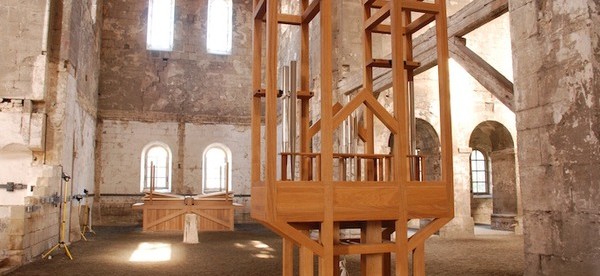You’ll Never Hear the End of This One


The German town of Halberstadt is home to about 40,000 people and, usually, it isn’t much of a spot for tourists to come visit. But there’s one exception: a pipe organ. Halberstadt is often credited with having the first ever pipe organ back in 1361, and while that organ is long gone, another famous one has taken its place. That pipe organ (above) is located at St. Burchardi’s church, and right now, it’s playing a chord.
It has been since 2013. And it will continue to do so, continuously, until September 5, 2020 — and then, it’ll switch to another chord.
The pipe organ at St. Burchardi’s is playing a song titled Organ²/ASLSP, better known as “As Slow As Possible.” The informal title tells the story — the song, composed by avant-garde composer John Cage in 1987, takes a very long time to play. Cage, basically, threw together a bunch of chords and added a simple tempo instruction: play the song “as slow as possible.” (It should be “slowly,” I think, but let’s not open that can of worms.) If you want to hear it — and don’t want to invest a lot of time in doing so — someone decided to ignore that instruction and instead play it as quickly as possible; that’s here, and it’ll take you less than a minute. If that speed is too grating to your ears and you can spare four minutes, here’s that version.
But those aren’t As Slow As Possible’s typical run-times. As the BBC explains, the composition “was originally a 20-minute piece for piano,” with many performances lasting more than an hour. And it can also be played in much, much longer amounts of time — and the organ at St. Burchardi’s takes this to the extreme. That version of As Slow As Possible began on September 5, 2001. It’ll end, if everything goes right, on September 5, 2640 — that’s 639 years from when it began.
The note changes happen by hand — the performer (who gets a lot of days off) adds or removes weights and pipes in order to create the desired sound. From there, physics takes over and the sound persists until the performer (or his or her successor) makes the next change. Beyond that, the organ just keeps on going. (As the New York Times notes, some other contingencies have also been accounted for: “solar power cells and a backup generator are on hand in case the electricity is interrupted.”) It’s a pretty easy gig — the first 17 months of the song were silent, as the score called for rest, and since then, there have been only a dozen changes. The most recent change occurred in October of 2013.
The project was the brainchild of some attendees of an organ conference which took place in 1997, where participants wondered exactly how long “possible” is when talking about “As Slow As Possible.” They didn’t reach a conclusion — some, per the above-linked Times article, noted that an organ can make a sound so long as the right keys are depressed, and that can be done without having a human doing the pressing — but they decided to run this stunt anyway. The 639-year duration was chosen because that was the duration between the first-ever organ (1361, as noted at the top) and the new millennium.
If you want to listen to it live online, you can’t really — the organ is behind acrylic in order to shield the surrounding area from a constant, unwavering tone, and the church doesn’t live-stream the music. However, it’s easy enough to simulate, and you can listen to the latest chord on the right sidebar of the project’s website. And if you can’t listen right now, don’t worry — you have a few years before the next change.
Bonus fact: You, too, can perform a John Cage piece — all you need is a musical instrument, a timer, and, ideally, a comfortable chair. The piece you’ll be performing is titled 4’33”, or “Four Minutes, 33 Seconds.” It has three movements and, as Wikipedia explains, it’s really easy to perform: “the score instructs the performer(s) not to play their instrument(s) during the entire duration of the piece throughout the three movements .” (Piano players often close or open the keyboard lid to mark each movement.) Cage’s hope wasn’t to create silence, though; his point was that ambient noise is, in some sense, music itself. You can judge for yourself, though; here’s a video of a performance of 4’33”.
From the Archives: Slow and Unsteady Wins the Sprint : Why the trick to winning a bicycle sprint is to go as slowly as possible. (Really, watch the video on that one, it’s just nuts.)
Related: A collection of John Cage’s music.Neither As Slow As Possible or 4’3″ are on the track listing, but you can simulate the latter after the rest of the collection completes playing.
